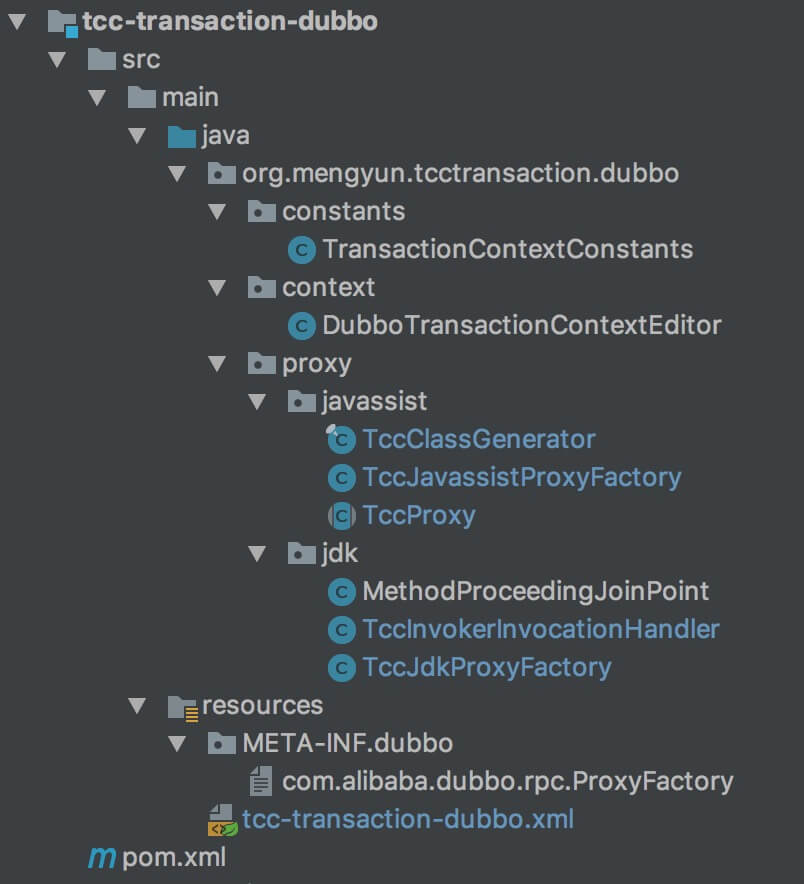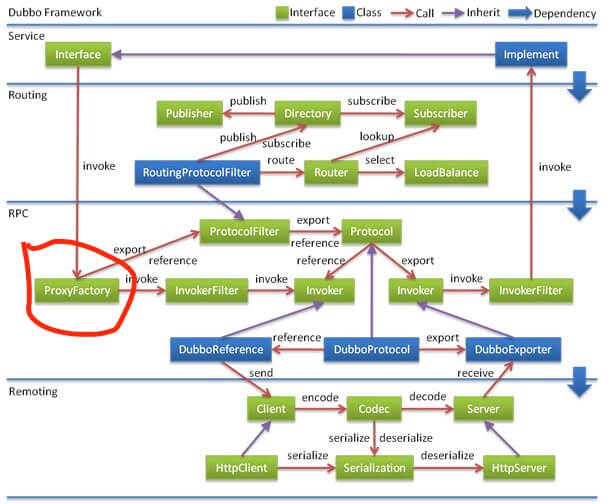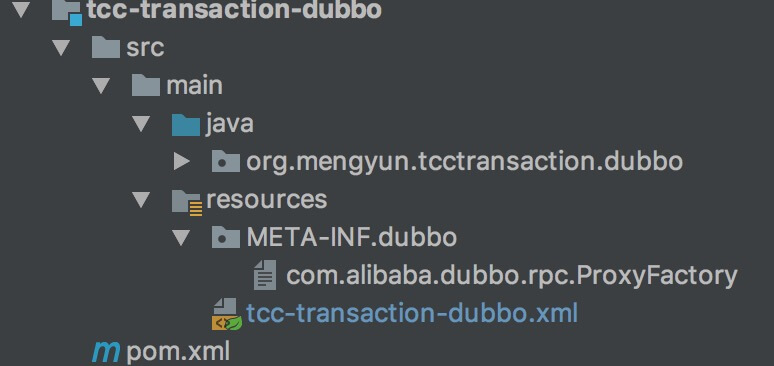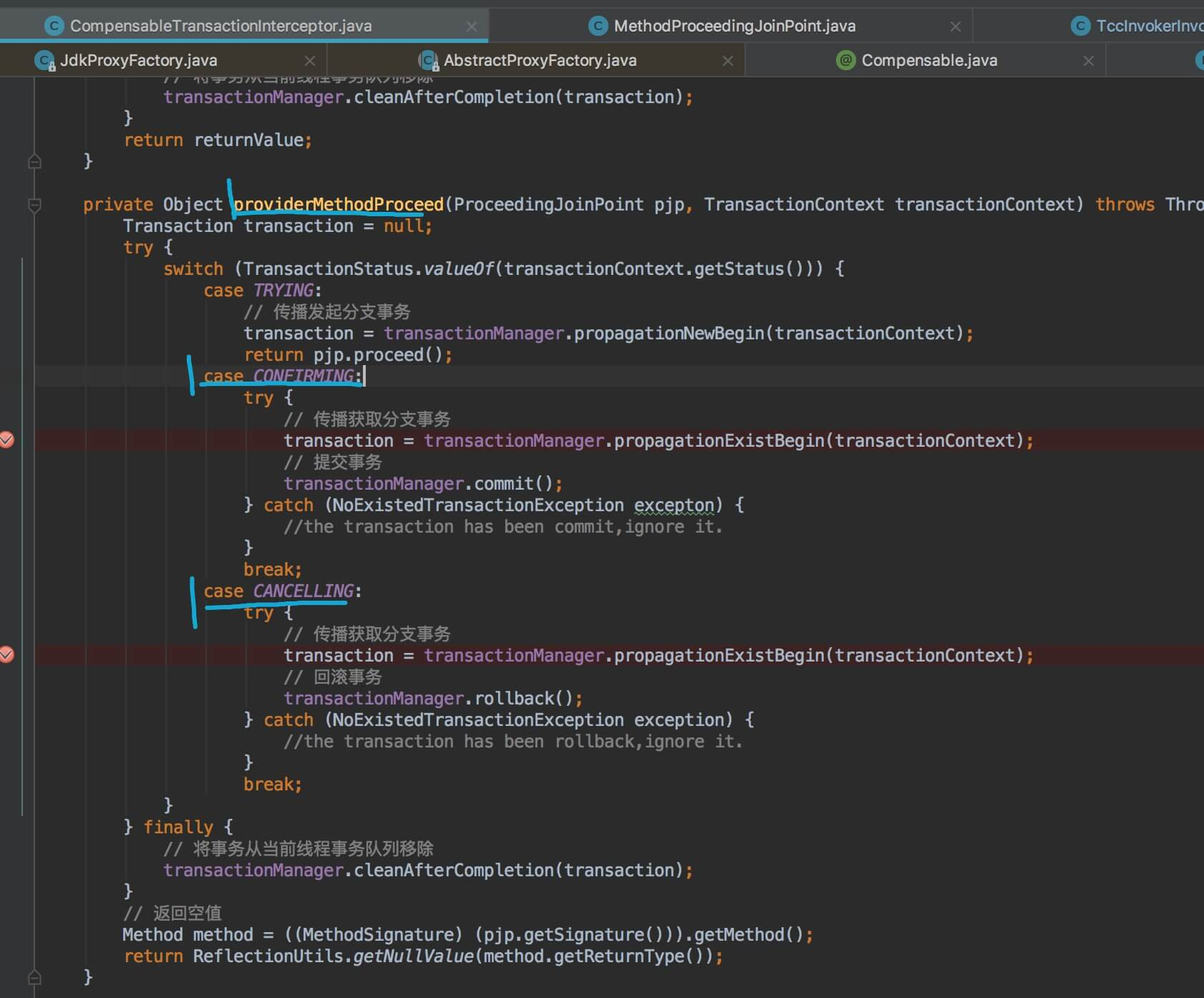摘要: 原创出处 http://www.iocoder.cn/TCC-Transaction/dubbo-support/ 「芋道源码」欢迎转载,保留摘要,谢谢!
本文主要基于 TCC-Transaction 1.2.3.3 正式版

🙂🙂🙂关注**微信公众号:【芋道源码】**有福利:
- RocketMQ / MyCAT / Sharding-JDBC 所有源码分析文章列表
- RocketMQ / MyCAT / Sharding-JDBC 中文注释源码 GitHub 地址
- 您对于源码的疑问每条留言都将得到认真回复。甚至不知道如何读源码也可以请教噢。
- 新的源码解析文章实时收到通知。每周更新一篇左右。
- 认真的源码交流微信群。
1. 概述
本文分享 Dubbo 支持。
TCC-Transaction 通过 Dubbo 隐式传参的功能,避免自己对业务代码的入侵。可能有同学不太理解为什么说 TCC-Transaction 对业务代码有一定的入侵性,一起来看个代码例子:
public interface CapitalTradeOrderService {
String record(TransactionContext transactionContext, CapitalTradeOrderDto tradeOrderDto);
}
- 代码来自
tcc-transaction-http-sample。声明远程调用时,增加了参数 TransactionContext。当然你也可以通过自己使用的远程调用框架做一定封装,避免入侵。
如下是对 Dubbo 封装了后,Dubbo Service 方法的例子:
public interface CapitalTradeOrderService {
@Compensable
String record(CapitalTradeOrderDto tradeOrderDto);
}
- 代码来自
http-transaction-dubbo-sample。是不是不需要传入参数 TransactionContext。当然,注解是肯定需要的,否则 TCC-Transaction 怎么知道哪些方法是 TCC 方法。
TCC-Transaction 通过 Dubbo Proxy 的机制,实现 @Compensable 属性自动生成,增加开发体验,也避免出错。
Dubbo 支持( Maven 项目 tcc-transaction-dubbo ) 整体代码结构如下:

proxycontext
我们分成两个小节分享这两个包实现的功能。
笔者暂时对 Dubbo 了解的不够深入,如果有错误的地方,还烦请指出,谢谢。
你行好事会因为得到赞赏而愉悦
同理,开源项目贡献者会因为 Star 而更加有动力
为 TCC-Transaction 点赞!传送门
ps:笔者假设你已经阅读过《tcc-transaction 官方文档 —— 使用指南1.2.x》。
2. Dubbo 代理
将 Dubbo Service 方法上的注解 @Compensable ,自动生成注解的 confirmMethod、cancelMethod、transactionContextEditor 属性,例子代码如下:
@Compensable(propagation=Propagation.SUPPORTS, confirmMethod="record", cancelMethod="record", transactionContextEditor=DubboTransactionContextEditor.class)
public String record(RedPacketTradeOrderDto paramRedPacketTradeOrderDto) {
// ... 省略代码
}
- 该代码通过 Javassist 生成的 Proxy 代码的示例。
propagation=Propagation.SUPPORTS:支持当前事务,如果当前没有事务,就以非事务方式执行。为什么不使用 REQUIRED ?如果使用 REQUIRED 事务传播级别,事务恢复重试时,会发起新的事务。confirmMethod、cancelMethod使用和 try 方法相同方法名:本地发起远程服务 TCC confirm / cancel 阶段,调用相同方法进行事务的提交或回滚。远程服务的 CompensableTransactionInterceptor 会根据事务的状态是 CONFIRMING / CANCELLING 来调用对应方法。transactionContextEditor=DubboTransactionContextEditor.class,使用 Dubbo 事务上下文编辑器,在「3. Dubbo 事务上下文编辑器」详细分享。
Dubbo Service Proxy 提供了两种生成方式:
- JavassistProxyFactory,基于 Javassist 方式
- JdkProxyFactory,基于 JDK 动态代理机制
这块内容我们不拓展开,感兴趣的同学点击如下文章:
Dubbo 的 Invoker 模型是非常关键的概念,看下图:

2.1 JavassistProxyFactory
2.1.1 Javassist
Javassist 是一个开源的分析、编辑和创建 Java 字节码的类库。通过使用Javassist 对字节码操作可以实现动态 ”AOP” 框架。
关于 Java 字节码的处理,目前有很多工具,如 bcel,asm( cglib只是对asm又封装了一层 )。不过这些都需要直接跟虚拟机指令打交道。
Javassist 的主要的优点,在于简单,而且快速,直接使用 Java 编码的形式,而不需要了解虚拟机指令,就能动态改变类的结构,或者动态生成类。
- 粗略一看,可能不够形象,下面我们通过看 TCC-Transaction 如何使用来理解理解。
- 《Java学习之javassist 》
- 《Javassist 字节码操作》
2.1.2 TccJavassistProxyFactory
org.mengyun.tcctransaction.dubbo.proxy.javassist.TccJavassistProxyFactory,TCC Javassist 代理工厂。实现代码如下:
public class TccJavassistProxyFactory extends JavassistProxyFactory {
@SuppressWarnings("unchecked")
public <T> T getProxy(Invoker<T> invoker, Class<?>[] interfaces) {
return (T) TccProxy.getProxy(interfaces).newInstance(new InvokerInvocationHandler(invoker));
}
}
- 项目启动时,调用
TccJavassistProxyFactory#getProxy(...)方法,生成 Dubbo Service 调用 Proxy。 com.alibaba.dubbo.rpc.proxy.InvokerInvocationHandler,Dubbo 调用处理器,点击连接查看代码。
2.1.3 TccProxy & TccClassGenerator
org.mengyun.tcctransaction.dubbo.proxy.javassist.TccProxy,TCC Proxy 工厂,生成 Dubbo Service 调用 Proxy 。笔者认为,TccProxy 改成 TccProxyFactory 更合适,原因在下文。
org.mengyun.tcctransaction.dubbo.proxy.javassist.TccClassGenerator,TCC 类代码生成器,基于 Javassist 实现。
🦅案例
一个 Dubbo Service,TccProxy 会动态生成两个类:
- Dubbo Service 调用 Proxy
- Dubbo Service 调用 ProxyFactory,生成对应的 Dubbo Service Proxy
例如 Dubbo Service 接口如下:
public interface RedPacketTradeOrderService {
@Compensable
String record(RedPacketTradeOrderDto tradeOrderDto);
}
生成 Dubbo Service 调用 ProxyFactory 如下 :
public class TccProxy3 extends TccProxy implements TccClassGenerator.DC {
public Object newInstance(InvocationHandler paramInvocationHandler) {
return new proxy3(paramInvocationHandler);
}
}
- TccProxy 提供
#newInstance(handler)方法,创建 Proxy,所以笔者认为,TccProxy 改成 TccProxyFactory 更合适。 org.mengyun.tcctransaction.dubbo.proxy.javassist.TccClassGenerator.DC动态生成类标记,标记该类由 TccClassGenerator 生成的。
生成 Dubbo Service 调用 Proxy 如下 :
public class proxy3 implements TccClassGenerator.DC, RedPacketTradeOrderService, EchoService {
public static Method[] methods;
private InvocationHandler handler;
public proxy3() {}
public proxy3(InvocationHandler paramInvocationHandler) {
this.handler = paramInvocationHandler;
}
@Compensable(propagation = Propagation.SUPPORTS, confirmMethod = "record", cancelMethod = "record", transactionContextEditor = DubboTransactionContextEditor.class)
public String record(RedPacketTradeOrderDto paramRedPacketTradeOrderDto) {
Object[] arrayOfObject = new Object[1];
arrayOfObject[0] = paramRedPacketTradeOrderDto;
Object localObject = this.handler.invoke(this, methods[0], arrayOfObject);
return (String) localObject;
}
public Object $echo(Object paramObject) {
Object[] arrayOfObject = new Object[1];
arrayOfObject[0] = paramObject;
Object localObject = this.handler.invoke(this, methods[1], arrayOfObject);
return (Object) localObject;
}
}
com.alibaba.dubbo.rpc.service.EchoService,Dubbo Service 回声服务接口,用于服务健康检查,Dubbo Service 默认自动实现该接口,点击连接查看代码。org.mengyun.tcctransaction.dubbo.proxy.javassist.TccClassGenerator.DC动态生成类标记,标记该类由 TccClassGenerator 生成的。
🦅实现
调用 TccProxy#getProxy(...) 方法,获得 TCC Proxy 工厂,实现代码如下:
1: // 【TccProxy.java】
2: public static TccProxy getProxy(ClassLoader cl, Class<?>... ics) {
3: // 校验接口超过上限
4: if (ics.length > 65535) {
5: throw new IllegalArgumentException("interface limit exceeded");
6: }
7:
8: // use interface class name list as key.
9: StringBuilder sb = new StringBuilder();
10: for (Class<?> ic : ics) {
11: String itf = ic.getName();
12: // 校验是否为接口
13: if (!ic.isInterface()) {
14: throw new RuntimeException(itf + " is not a interface.");
15: }
16: // 加载接口类
17: Class<?> tmp = null;
18: try {
19: tmp = Class.forName(itf, false, cl);
20: } catch (ClassNotFoundException ignored) {
21: }
22: if (tmp != ic) { // 加载接口类失败
23: throw new IllegalArgumentException(ic + " is not visible from class loader");
24: }
25: sb.append(itf).append(';');
26: }
27: String key = sb.toString();
28:
29: // get cache by class loader.
30: Map<String, Object> cache;
31: synchronized (ProxyCacheMap) {
32: cache = ProxyCacheMap.get(cl);
33: if (cache == null) {
34: cache = new HashMap<String, Object>();
35: ProxyCacheMap.put(cl, cache);
36: }
37: }
38:
39: // 获得 TccProxy 工厂
40: TccProxy proxy = null;
41: synchronized (cache) {
42: do {
43: // 从缓存中获取 TccProxy 工厂
44: Object value = cache.get(key);
45: if (value instanceof Reference<?>) {
46: proxy = (TccProxy) ((Reference<?>) value).get();
47: if (proxy != null) {
48: return proxy;
49: }
50: }
51: // 缓存中不存在,设置生成 TccProxy 代码标记。创建中时,其他创建请求等待,避免并发。
52: if (value == PendingGenerationMarker) {
53: try {
54: cache.wait();
55: } catch (InterruptedException ignored) {
56: }
57: } else {
58: cache.put(key, PendingGenerationMarker);
59: break;
60: }
61: }
62: while (true);
63: }
64:
65: long id = PROXY_CLASS_COUNTER.getAndIncrement();
66: String pkg = null;
67: TccClassGenerator ccp = null; // proxy class generator
68: TccClassGenerator ccm = null; // proxy factory class generator
69: try {
70: // 创建 Tcc class 代码生成器
71: ccp = TccClassGenerator.newInstance(cl);
72:
73: Set<String> worked = new HashSet<String>(); // 已处理方法签名集合。key:方法签名
74: List<Method> methods = new ArrayList<Method>(); // 已处理方法集合。
75:
76: // 处理接口
77: for (Class<?> ic : ics) {
78: // 非 public 接口,使用接口包名
79: if (!Modifier.isPublic(ic.getModifiers())) {
80: String npkg = ic.getPackage().getName();
81: if (pkg == null) {
82: pkg = npkg;
83: } else {
84: if (!pkg.equals(npkg)) { // 实现了两个非 public 的接口,
85: throw new IllegalArgumentException("non-public interfaces from different packages");
86: }
87: }
88: }
89: // 添加接口
90: ccp.addInterface(ic);
91: // 处理接口方法
92: for (Method method : ic.getMethods()) {
93: // 添加方法签名到已处理方法签名集合
94: String desc = ReflectUtils.getDesc(method);
95: if (worked.contains(desc)) {
96: continue;
97: }
98: worked.add(desc);
99: // 生成接口方法实现代码
100: int ix = methods.size();
101: Class<?> rt = method.getReturnType();
102: Class<?>[] pts = method.getParameterTypes();
103: StringBuilder code = new StringBuilder("Object[] args = new Object[").append(pts.length).append("];");
104: for (int j = 0; j < pts.length; j++) {
105: code.append(" args[").append(j).append("] = ($w)$").append(j + 1).append(";");
106: }
107: code.append(" Object ret = handler.invoke(this, methods[").append(ix).append("], args);");
108: if (!Void.TYPE.equals(rt)) {
109: code.append(" return ").append(asArgument(rt, "ret")).append(";");
110: }
111: methods.add(method);
112: // 添加方法
113: Compensable compensable = method.getAnnotation(Compensable.class);
114: if (compensable != null) {
115: ccp.addMethod(true, method.getName(), method.getModifiers(), rt, pts, method.getExceptionTypes(), code.toString());
116: } else {
117: ccp.addMethod(false, method.getName(), method.getModifiers(), rt, pts, method.getExceptionTypes(), code.toString());
118: }
119: }
120: }
121:
122: // 设置包路径
123: if (pkg == null) {
124: pkg = PACKAGE_NAME;
125: }
126:
127: // create ProxyInstance class.
128: // 设置类名
129: String pcn = pkg + ".proxy" + id;
130: ccp.setClassName(pcn);
131: // 添加静态属性 methods
132: ccp.addField("public static java.lang.reflect.Method[] methods;");
133: // 添加属性 handler
134: ccp.addField("private " + InvocationHandler.class.getName() + " handler;");
135: // 添加构造方法,参数 handler
136: ccp.addConstructor(Modifier.PUBLIC, new Class<?>[]{InvocationHandler.class}, new Class<?>[0], "handler=$1;");
137: // 添加构造方法,参数 空
138: ccp.addDefaultConstructor();
139: // 生成类
140: Class<?> clazz = ccp.toClass();
141: // 设置静态属性 methods
142: clazz.getField("methods").set(null, methods.toArray(new Method[0]));
143:
144: // create TccProxy class.
145: // 创建 Tcc class 代码生成器
146: ccm = TccClassGenerator.newInstance(cl);
147: // 设置类名
148: String fcn = TccProxy.class.getName() + id;
149: ccm.setClassName(fcn);
150: // 添加构造方法,参数 空
151: ccm.addDefaultConstructor();
152: // 设置父类为 TccProxy.class
153: ccm.setSuperClass(TccProxy.class);
154: // 添加方法 #newInstance(handler)
155: ccm.addMethod("public Object newInstance(" + InvocationHandler.class.getName() + " h){ return new " + pcn + "($1); }");
156: // 生成类
157: Class<?> pc = ccm.toClass();
158: // 创建 TccProxy 对象
159: proxy = (TccProxy) pc.newInstance();
160: } catch (RuntimeException e) {
161: throw e;
162: } catch (Exception e) {
163: throw new RuntimeException(e.getMessage(), e);
164: } finally {
165: // release TccClassGenerator
166: if (ccp != null) {
167: ccp.release();
168: }
169: if (ccm != null) {
170: ccm.release();
171: }
172: // 唤醒缓存 wait
173: synchronized (cache) {
174: if (proxy == null) {
175: cache.remove(key);
176: } else {
177: cache.put(key, new WeakReference<TccProxy>(proxy));
178: }
179: cache.notifyAll();
180: }
181: }
182: return proxy;
183: }
-
第 3 至 7 行 :校验接口超过上限。
-
第 8 至 27 行 :使用接口集合类名以
;分隔拼接,作为 Proxy 的唯一标识。例如 :key=org.mengyun.tcctransaction.sample.dubbo.redpacket.api.RedPacketAccountService;com.alibaba.dubbo.rpc.service.EchoService;。 -
第 29 至 37 行 :获得 Proxy 对应的 ClassLoader。这里我们看下静态属性
ProxyCacheMap的定义:/** * Proxy 对象缓存 * key :ClassLoader * value.key :Tcc Proxy 标识。使用 Tcc Proxy 实现接口名拼接 * value.value :Tcc Proxy 工厂对象 */ private static final Map<ClassLoader, Map<String, Object>> ProxyCacheMap = new WeakHashMap<ClassLoader, Map<String, Object>>();- 使用 WeakHashMap,当 ClassLoader 被回收时,其对应的值一起被移除。
- 《WeakHashMap和HashMap的区别》
- 《Java 集合系列13之 WeakHashMap详细介绍(源码解析)和使用示例》
-
第 39 至 63 行 :一直获得 TCC Proxy 工厂直到成功。
- 第 43 至 50 行 :从缓存中获取 TCC Proxy 工厂。
- 第 51 至 60 行 :若缓存中不存在,设置正在生成 TccProxy 代码标记。创建中时,其他创建请求等待,避免并发。
-
第 65 行 :
PROXY_CLASS_COUNTER,Proxy Class 计数,用于生成 Proxy 类名自增。代码如下:private static final AtomicLong PROXY_CLASS_COUNTER = new AtomicLong(0); -
第 66 至 67 行
ccm,生成 Dubbo Service 调用 ProxyFactory 的代码生成器ccp,生成 Dubbo Service 调用 Proxy 的代码生成器
-
第 70 至 142 行 :生成 Dubbo Service 调用 Proxy 的代码。
-
第 70 至 71 行 :调用
TccClassGenerator#newInstance(loader)方法, 创建生成 Dubbo Service 调用 Proxy 的代码生成器。实现代码如下:// TccClassGenerator.java public final class TccClassGenerator { /** * CtClass hash 集合 * key:类名 */ private ClassPool mPool; public static TccClassGenerator newInstance(ClassLoader loader) { return new TccClassGenerator(getClassPool(loader)); } private TccClassGenerator(ClassPool pool) { mPool = pool; } }- ClassPool 是一个 CtClass 对象的 hash 表,类名做为 key 。ClassPool 的
#get(key)搜索 hash 表找到与指定 key 关联的 CtClass 对象。如果没有找到 CtClass 对象,#get(key)读一个类文件构建新的 CtClass 对象,它是被记录在 hash 表中然后返回这个对象。
- ClassPool 是一个 CtClass 对象的 hash 表,类名做为 key 。ClassPool 的
-
第 76 至 120 行,处理接口。
-
第 79 至 88 行,生成类的包名。
-
第 89 至 90 行,调用
TccClassGenerator#addInterface(cl)方法,添加生成类的接口( Dubbo Service 接口 )。实现代码如下:/** * 生成类的接口集合 */ private Set<String> mInterfaces; public TccClassGenerator addInterface(Class<?> cl) { return addInterface(cl.getName()); } public TccClassGenerator addInterface(String cn) { if (mInterfaces == null) { mInterfaces = new HashSet<String>(); } mInterfaces.add(cn); return this; }- x
-
第 93 至 98 行,添加方法签名到已处理方法签名集合。多个接口可能存在相同的接口方法,跳过相同的方法,避免冲突。
-
第 99 至 110 行,生成 Dubbo Service 调用实现代码。案例代码如下:
public String record(RedPacketTradeOrderDto paramRedPacketTradeOrderDto) { Object[] arrayOfObject = new Object[1]; arrayOfObject[0] = paramRedPacketTradeOrderDto; Object localObject = this.handler.invoke(this, methods[0], arrayOfObject); return (String)localObject; } -
第 112 至 118 行 :调用
TccClassGenerator#addMethod(...)方法,添加生成的方法。实现代码如下:/** * 生成类的方法代码集合 */ private List<String> mMethods; /** * 带 @Compensable 方法代码集合 */ private Set<String> compensableMethods = new HashSet<String>(); public TccClassGenerator addMethod(boolean isCompensableMethod, String name, int mod, Class<?> rt, Class<?>[] pts, Class<?>[] ets, String body) { // 拼接方法 StringBuilder sb = new StringBuilder(); sb.append(modifier(mod)).append(' ').append(ReflectUtils.getName(rt)).append(' ').append(name); sb.append('('); for (int i = 0; i < pts.length; i++) { if (i > 0) sb.append(','); sb.append(ReflectUtils.getName(pts[i])); sb.append(" arg").append(i); } sb.append(')'); if (ets != null && ets.length > 0) { sb.append(" throws "); for (int i = 0; i < ets.length; i++) { if (i > 0) sb.append(','); sb.append(ReflectUtils.getName(ets[i])); } } sb.append('{').append(body).append('}'); // 是否有 @Compensable 注解 if (isCompensableMethod) { compensableMethods.add(sb.toString()); } return addMethod(sb.toString()); } public TccClassGenerator addMethod(String code) { if (mMethods == null) { mMethods = new ArrayList<String>(); } mMethods.add(code); return this; }
-
-
第 122 至 130 行,生成类名( 例如,
org.mengyun.tcctransaction.dubbo.proxy.javassist.proxy3),并调用TccClassGenerator#setClassName(...)方法,设置类名。实现代码如下:/** * 生成类的类名 */ private String mClassName; public TccClassGenerator setClassName(String name) { mClassName = name; return this; }- x
-
第 131 至 134 行,调用
TccClassGenerator#addField(...)方法,添加静态属性methods( Dubbo Service 方法集合 )和属性handler( Dubbo InvocationHandler )。实现代码如下:/** * 生成类的属性集合 */ private List<String> mFields; public TccClassGenerator addField(String code) { if (mFields == null) { mFields = new ArrayList<String>(); } mFields.add(code); return this; }- x
-
第 135 至 136 行,调用
TccClassGenerator#addConstructor(...)方法,添加参数为handler的构造方法。实现代码如下:/** * 生成类的非空构造方法代码集合 */ private List<String> mConstructors; public TccClassGenerator addConstructor(int mod, Class<?>[] pts, Class<?>[] ets, String body) { // 构造方法代码 StringBuilder sb = new StringBuilder(); sb.append(modifier(mod)).append(' ').append(SIMPLE_NAME_TAG); sb.append('('); for (int i = 0; i < pts.length; i++) { if (i > 0) sb.append(','); sb.append(ReflectUtils.getName(pts[i])); sb.append(" arg").append(i); } sb.append(')'); if (ets != null && ets.length > 0) { sb.append(" throws "); for (int i = 0; i < ets.length; i++) { if (i > 0) sb.append(','); sb.append(ReflectUtils.getName(ets[i])); } } sb.append('{').append(body).append('}'); // return addConstructor(sb.toString()); } public TccClassGenerator addConstructor(String code) { if (mConstructors == null) { mConstructors = new LinkedList<String>(); } mConstructors.add(code); return this; } public TccClassGenerator addConstructor(String code) { if (mConstructors == null) { mConstructors = new LinkedList<String>(); } mConstructors.add(code); return this; }- x
-
第 137 至 138 行,调用
TccClassGenerator#addDefaultConstructor()方法,添加默认空构造方法。实现代码如下:/** * 默认空构造方法 */ private boolean mDefaultConstructor = false; public TccClassGenerator addDefaultConstructor() { mDefaultConstructor = true; return this; }- x
-
第 139 行,调用
TccClassGenerator#toClass()方法,生成类。实现代码如下:1: public Class<?> toClass() { 2: // mCtc 非空时,进行释放;下面会进行创建 mCtc 3: if (mCtc != null) { 4: mCtc.detach(); 5: } 6: long id = CLASS_NAME_COUNTER.getAndIncrement(); 7: try { 8: CtClass ctcs = mSuperClass == null ? null : mPool.get(mSuperClass); 9: if (mClassName == null) { // 类名 10: mClassName = (mSuperClass == null || javassist.Modifier.isPublic(ctcs.getModifiers()) 11: ? TccClassGenerator.class.getName() : mSuperClass + "$sc") + id; 12: } 13: // 创建 mCtc 14: mCtc = mPool.makeClass(mClassName); 15: if (mSuperClass != null) { // 继承类 16: mCtc.setSuperclass(ctcs); 17: } 18: mCtc.addInterface(mPool.get(DC.class.getName())); // add dynamic class tag. 19: if (mInterfaces != null) { // 实现接口集合 20: for (String cl : mInterfaces) { 21: mCtc.addInterface(mPool.get(cl)); 22: } 23: } 24: if (mFields != null) { // 属性集合 25: for (String code : mFields) { 26: mCtc.addField(CtField.make(code, mCtc)); 27: } 28: } 29: if (mMethods != null) { // 方法集合 30: for (String code : mMethods) { 31: if (code.charAt(0) == ':') { 32: mCtc.addMethod(CtNewMethod.copy(getCtMethod(mCopyMethods.get(code.substring(1))), code.substring(1, code.indexOf('(')), mCtc, null)); 33: } else { 34: CtMethod ctMethod = CtNewMethod.make(code, mCtc); 35: if (compensableMethods.contains(code)) { 36: // 设置 @Compensable 属性 37: ConstPool constpool = mCtc.getClassFile().getConstPool(); 38: AnnotationsAttribute attr = new AnnotationsAttribute(constpool, AnnotationsAttribute.visibleTag); 39: Annotation annot = new Annotation("org.mengyun.tcctransaction.api.Compensable", constpool); 40: EnumMemberValue enumMemberValue = new EnumMemberValue(constpool); 41: enumMemberValue.setType("org.mengyun.tcctransaction.api.Propagation"); 42: enumMemberValue.setValue("SUPPORTS"); 43: annot.addMemberValue("propagation", enumMemberValue); 44: annot.addMemberValue("confirmMethod", new StringMemberValue(ctMethod.getName(), constpool)); 45: annot.addMemberValue("cancelMethod", new StringMemberValue(ctMethod.getName(), constpool)); 46: ClassMemberValue classMemberValue = new ClassMemberValue("org.mengyun.tcctransaction.dubbo.context.DubboTransactionContextEditor", constpool); 47: annot.addMemberValue("transactionContextEditor", classMemberValue); 48: attr.addAnnotation(annot); 49: ctMethod.getMethodInfo().addAttribute(attr); 50: } 51: mCtc.addMethod(ctMethod); 52: } 53: } 54: } 55: if (mDefaultConstructor) { // 空参数构造方法 56: mCtc.addConstructor(CtNewConstructor.defaultConstructor(mCtc)); 57: } 58: if (mConstructors != null) { // 带参数构造方法 59: for (String code : mConstructors) { 60: if (code.charAt(0) == ':') { 61: mCtc.addConstructor(CtNewConstructor.copy(getCtConstructor(mCopyConstructors.get(code.substring(1))), mCtc, null)); 62: } else { 63: String[] sn = mCtc.getSimpleName().split("\\$+"); // inner class name include $. 64: mCtc.addConstructor(CtNewConstructor.make(code.replaceFirst(SIMPLE_NAME_TAG, sn[sn.length - 1]), mCtc)); 65: } 66: } 67: } 68: // mCtc.debugWriteFile("/Users/yunai/test/" + mCtc.getSimpleName().replaceAll(".", "/") + ".class"); 69: // 生成 70: return mCtc.toClass(); 71: } catch (RuntimeException e) { 72: throw e; 73: } catch (NotFoundException e) { 74: throw new RuntimeException(e.getMessage(), e); 75: } catch (CannotCompileException e) { 76: throw new RuntimeException(e.getMessage(), e); 77: } 78: }- 基于 Javassist 生成类。这里不做拓展解释,配合《Java学习之javassist》一起理解。
- 第 18 行,添加
org.mengyun.tcctransaction.dubbo.proxy.javassist.TccClassGenerator.DC动态生成类标记,标记该类由 TccClassGenerator 生成的。 - 第 34 至 50 行,设置 @Compensable 默认属性。
-
第 141 至 142 行,设置 Dubbo Service 方法集合设置到静态属性
methods上。
-
-
第 144 至 157 行,生成 Dubbo Service 调用 Proxy 工厂的代码。
-
第 146 行,调用
TccClassGenerator#newInstance(loader)方法, 创建生成 Dubbo Service 调用 Proxy 工厂 的代码生成器。 -
第 147 至 149 行,生成类名( 例如,
org.mengyun.tcctransaction.dubbo.proxy.javassist.TccProxy3),并调用TccClassGenerator#setClassName(...)方法,设置类名。 -
第 150 至 151 行,调用
TccClassGenerator#addDefaultConstructor()方法,添加默认空构造方法。 -
第 152 至 153 行,调用
TccClassGenerator#mSuperClass()方法,设置继承父类TccProxy。实现代码如下:/** * 生成类的父类名字 */ private String mSuperClass; public TccClassGenerator setSuperClass(Class<?> cl) { mSuperClass = cl.getName(); return this; }- x
-
第 154 至 155 行,调用
TccClassGenerator#addInterface(cl)方法,添加生成 Proxy 实现代码的方法。代码案例如下:public Object newInstance(InvocationHandler paramInvocationHandler) { return new proxy3(paramInvocationHandler); }- x
-
第 156 至 157 行,调用
TccClassGenerator#toClass()方法,生成类。
-
-
第 159 行,调用
TccProxy#newInstance()方法,创建 Proxy 。实现代码如下:/** * get instance with default handler. * * @return instance. */ public Object newInstance() { return newInstance(THROW_UNSUPPORTED_INVOKER); } /** * get instance with special handler. * * @return instance. */ abstract public Object newInstance(InvocationHandler handler);#newInstance(handler),抽象方法,上面第 154 至 155 行生成。TccJavassistProxyFactory 调用该方法,获得 Proxy 。
-
第 165 至 171 行,释放 TccClassGenerator 。实现代码如下:
public void release() { if (mCtc != null) { mCtc.detach(); } if (mInterfaces != null) { mInterfaces.clear(); } if (mFields != null) { mFields.clear(); } if (mMethods != null) { mMethods.clear(); } if (mConstructors != null) { mConstructors.clear(); } if (mCopyMethods != null) { mCopyMethods.clear(); } if (mCopyConstructors != null) { mCopyConstructors.clear(); } } -
第 172 至 180 行,设置 Proxy 工厂缓存,并唤醒等待线程。
**ps:**代码比较多,收获会比较多,算是 Javassist 实战案例了。TCC-Transaction 作者在实现上述类,可能参考了 Dubbo 自带的实现:
com.alibaba.dubbo.common.bytecode.Proxycom.alibaba.dubbo.common.bytecode.ClassGeneratorcom.alibaba.dubbo.common.bytecode.Wrapper
2.1.4 配置 Dubbo Proxy
// META-INF.dubbo/com.alibaba.dubbo.rpc.ProxyFactory
tccJavassist=org.mengyun.tcctransaction.dubbo.proxy.javassist.TccJavassistProxyFactory
// tcc-transaction-dubbo.xml
<dubbo:provider proxy="tccJavassist"/>
目前 Maven 项目 tcc-transaction-dubbo 已经默认配置,引入即可。

2.2 JdkProxyFactory
2.2.1 JDK Proxy
《 Java JDK 动态代理(AOP)使用及实现原理分析》
2.2.2 TccJdkProxyFactory
org.mengyun.tcctransaction.dubbo.proxy.jd.TccJdkProxyFactory,TCC JDK 代理工厂。实现代码如下:
public class TccJdkProxyFactory extends JdkProxyFactory {
@SuppressWarnings("unchecked")
public <T> T getProxy(Invoker<T> invoker, Class<?>[] interfaces) {
T proxy = (T) Proxy.newProxyInstance(Thread.currentThread().getContextClassLoader(), interfaces, new InvokerInvocationHandler(invoker));
return (T) Proxy.newProxyInstance(Thread.currentThread().getContextClassLoader(), interfaces, new TccInvokerInvocationHandler(proxy, invoker));
}
}
- 项目启动时,调用
TccJavassistProxyFactory#getProxy(...)方法,生成 Dubbo Service 调用 Proxy。 - 第一次调用
Proxy#newProxyInstance(...)方法,创建调用 Dubbo Service 服务的 Proxy。com.alibaba.dubbo.rpc.proxy.InvokerInvocationHandler,Dubbo 调用处理器,点击连接查看代码。 - 第二次调用
Proxy#newProxyInstance(...)方法,创建对调用 Dubbo Service 的 Proxy 的 Proxy。为什么会有两层 Proxy?答案在下节 TccInvokerInvocationHandler 。
2.2.3 TccInvokerInvocationHandler
org.mengyun.tcctransaction.dubbo.proxy.jdk.TccInvokerInvocationHandler,TCC 调用处理器,在调用 Dubbo Service 服务时,使用 ResourceCoordinatorInterceptor 拦截处理。实现代码如下:
1: public class TccInvokerInvocationHandler extends InvokerInvocationHandler {
2:
3: /**
4: * proxy
5: */
6: private Object target;
7:
8: public TccInvokerInvocationHandler(Invoker<?> handler) {
9: super(handler);
10: }
11:
12: public <T> TccInvokerInvocationHandler(T target, Invoker<T> invoker) {
13: super(invoker);
14: this.target = target;
15: }
16:
17: public Object invoke(Object proxy, Method method, Object[] args) throws Throwable {
18: Compensable compensable = method.getAnnotation(Compensable.class);
19: if (compensable != null) {
20: // 设置 @Compensable 属性
21: if (StringUtils.isEmpty(compensable.confirmMethod())) {
22: ReflectionUtils.changeAnnotationValue(compensable, "confirmMethod", method.getName());
23: ReflectionUtils.changeAnnotationValue(compensable, "cancelMethod", method.getName());
24: ReflectionUtils.changeAnnotationValue(compensable, "transactionContextEditor", DubboTransactionContextEditor.class);
25: ReflectionUtils.changeAnnotationValue(compensable, "propagation", Propagation.SUPPORTS);
26: }
27: // 生成切面
28: ProceedingJoinPoint pjp = new MethodProceedingJoinPoint(proxy, target, method, args);
29: // 执行
30: return FactoryBuilder.factoryOf(ResourceCoordinatorAspect.class).getInstance().interceptTransactionContextMethod(pjp);
31: } else {
32: return super.invoke(target, method, args);
33: }
34: }
35:
36: }
-
第 18 至 26 行,设置带有 @Compensable 属性的默认属性。
-
第 28 行,生成方法切面
org.mengyun.tcctransaction.dubbo.proxy.jdk.MethodProceedingJoinPoint。实现代码如下:public class MethodProceedingJoinPoint implements ProceedingJoinPoint, JoinPoint.StaticPart { /** * 代理对象 */ private Object proxy; /** * 目标对象 */ private Object target; /** * 方法 */ private Method method; /** * 参数 */ private Object[] args; @Override public Object proceed() throws Throwable { // Use reflection to invoke the method. try { ReflectionUtils.makeAccessible(method); return method.invoke(target, args); } catch (InvocationTargetException ex) { // Invoked method threw a checked exception. // We must rethrow it. The client won't see the interceptor. throw ex.getTargetException(); } catch (IllegalArgumentException ex) { throw new SystemException("Tried calling method [" + method + "] on target [" + target + "] failed", ex); } catch (IllegalAccessException ex) { throw new SystemException("Could not access method [" + method + "]", ex); } } @Override public Object proceed(Object[] objects) throws Throwable { // throw new UnsupportedOperationException(); // TODO 芋艿:疑问 return proceed(); } // ... 省略不重要的方法和对象 }- 该类参考
org.springframework.aop.aspectj.MethodInvocationProceedingJoinPoint实现。 - TODO【1】 proxy 和 target 是否保留一个即可?
- 在切面处理完成后,调用
#proceed(...)方法,进行远程 Dubbo Service 服务调用。 - TODO【2】
#proceed(objects)抛出 throw new UnsupportedOperationException();。需要跟作者确认下。
- 该类参考
-
调用
ResourceCoordinatorAspect#interceptTransactionContextMethod(...)方法,对方法切面拦截处理。为什么无需调用 CompensableTransactionAspect 切面?因为传播级别为 Propagation.SUPPORTS,不会发起事务。
2.2.4 配置 Dubbo Proxy
// META-INF.dubbo/com.alibaba.dubbo.rpc.ProxyFactory
tccJdk=org.mengyun.tcctransaction.dubbo.proxy.jdk.TccJdkProxyFactory
// appcontext-service-dubbo.xml
<dubbo:provider proxy="tccJdk"/>
<dubbo:reference proxy="tccJdk" id="captialTradeOrderService"
interface="org.mengyun.tcctransaction.sample.dubbo.capital.api.CapitalTradeOrderService" timeout="5000"/>
- ProxyFactory 的
tccJdk在 Maven 项tcc-transaction-dubbo已经声明。 - 声明
dubbo:provider的proxy="tccJdk"。 - 声明
dubbo:reference的proxy="tccJdk",否则不生效。
3. Dubbo 事务上下文编辑器
org.mengyun.tcctransaction.dubbo.context.DubboTransactionContextEditor,Dubbo 事务上下文编辑器实现,实现代码如下:
public class DubboTransactionContextEditor implements TransactionContextEditor {
@Override
public TransactionContext get(Object target, Method method, Object[] args) {
String context = RpcContext.getContext().getAttachment(TransactionContextConstants.TRANSACTION_CONTEXT);
if (StringUtils.isNotEmpty(context)) {
return JSON.parseObject(context, TransactionContext.class);
}
return null;
}
@Override
public void set(TransactionContext transactionContext, Object target, Method method, Object[] args) {
RpcContext.getContext().setAttachment(TransactionContextConstants.TRANSACTION_CONTEXT, JSON.toJSONString(transactionContext));
}
}
- 通过 Dubbo 的隐式传参的方式,避免在 Dubbo Service 接口上声明 TransactionContext 参数,对接口产生一定的入侵。
666. 彩蛋

HOHO,对动态代理又学习了一遍,蛮 High 的。
这里推荐动态代理无关,和 Dubbo 相关的文章:

胖友,分享一波朋友圈可好。

